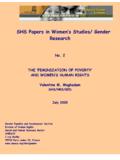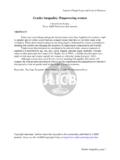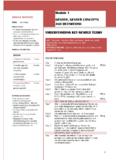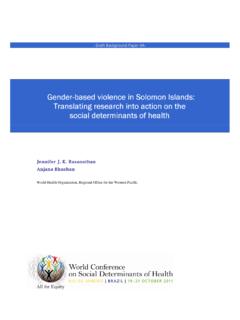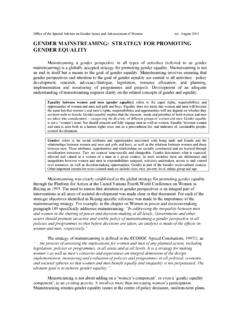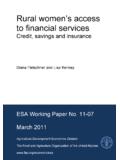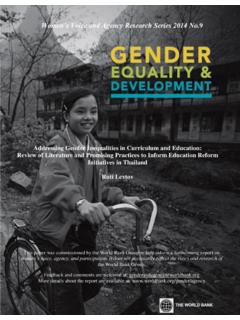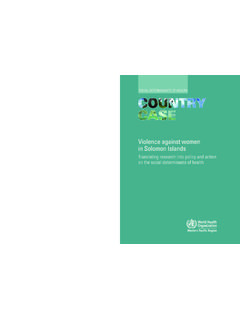Transcription of andTO - WHO | World Health Organization
1 Health andandTOTODAY S EVIDENCETOMORROW S AGENDAWHO Library Cataloguing-in-Publication Data: women and Health : today's evidence tomorrow's agenda. 's Health . 's Health services - trends. change events. status indicators. justice. identity. policy. Health . countries. Health Organization . ISBN 978 92 4 156385 7 (NLM classification: WA 309) World Health Organization 2009 All rights reserved. Publications of the World Health Organization can be obtained from WHO Press, World Health Organization , 20 Avenue Appia, 1211 Geneva 27, Switzerland (tel.: +41 22 791 3264; fax: +41 22 791 4857; e-mail: Requests for permis-sion to reproduce or translate WHO publications whether for sale or for noncommercial distribution should be addressed to WHO Press, at the above address (fax: +41 22 791 4806; e-mail: The designations employed and the presentation of the material in this publication do not imply the expression of any opinion whatsoever on the part of the World Health Organization concerning the legal status of any country, territory, city or area or of its authorities, or concerning the delimitation of its frontiers or boundaries.))
2 Dotted lines on maps represent approximate border lines for which there may not yet be full mention of specific companies or of certain manufacturers products does not imply that they are endorsed or recommended by the World Health Organization in preference to others of a similar nature that are not mentioned. Errors and omissions excepted, the names of proprietary products are distinguished by initial capital reasonable precautions have been taken by the World Health Organization to verify the information contained in this publication. However, the published material is being distributed without warranty of any kind, either expressed or implied. The responsibility for the interpretation and use of the material lies with the reader.
3 In no event shall the World Health Organization be liable for damages arising from its use. AcknowledgementsThis report was produced under the overall direction of Assistant Directors-General Tim Evans and Daisy Mafubelu. The editorial team members were, in alphabetical order, Carla AbouZahr, Isabelle de Zoysa and Claudia Garc a Moreno. Valuable inputs were provided by Ties Boerma, Andrew Cassels, Susan Holck, Colin Mathers and Thomson were received from: Jonathan Abrahams, Fiona Adshead, Adelio Antunes, Timothy Armstrong, Gini Arnold, Parijat Baijal, Anand Balachandran, John Beard, Douglas Bettcher, Michel Beusenberg, Paul Bloem, Monika Bl ssner, Sophie Bonjour, Cynthia Boschi-Pinto, Francesco Branca, Nathalie Broutet, Marie-Noel Brune, Tony Burton, Alexander Butchart, Txema Calleja, Diarmid Campbell-Lundrum, Guy Carrin, Andrew Cassels, Somnath Chatterji, Rudi Coninx, Melanie Cowan, Catherine d Arcanques, Mercedes de Onis, Bruce Dick, Tarun Dua, Varatharajan Durairaj, David Evans, Jane Ferguson, Daniela Fuhr, Lisa Garbus, Peter Ghys, Philip Glaziou, Fiona Gore, Rifat Hossein, Ahmadreza Hosseinpoor, Mie Inoue, V ronique Joseph, Mary Kay Kindhauser, Evelyn Kortum.
4 Tanya Kuchenmuller, Jennifer Lee, Sun Goo Lee, Wim Van Lerberghe, Doris Ma Fat, Jos Martines, Elizabeth Mason, Pamela Sabina Mbabazi, Christopher Mikton, Charles Mock, Nirmala Naidoo, Francis Ndowa, Joerdis Ott, Heather Papowitz, Razia Pendse, Judy Polsky, Yongyuth Pongsupap, Vladimir Poznyak, Annette Pr ss-Ust n, Eva Rehfuess, Chen Reis, Leanne Riley, Lisa Rogers, Ritu Sadana, Shekhar Saxena, Lale Say, George Schmid, Archana Narendra Shah, Iqbal Shah, Ferid Shannoun, Kurup Anand Sivasankara, Amani Siyam, Yves Souteyrand, Marcus Stalhofer, Claudia Stein, Gretchen Stevens, Joanna Tempowski, Shyam Thapa, Andreas Ullrich, Constanza Vallenas, Annette Verster, Susan Wilburn, Sachiyo Yoshida and Dongbao comments were provided by Mahmoud Fatallah, Sharon Fonn, Adrienne Germain, Piroska Ostlin, Sundari Ravindran, Sheila Tlou and Tomris T thanks go to the Department of Health Care Policy, Harvard Medical School Robert Jin, Ronald C.
5 Kessler and Nancy Sampson for the analysis of women and mental ill- Health writing support was provided by Gary Humphries and Diane Summers. The report was edited by David Bramley and proof-read by Diana Hopkins. The index was prepared by June Morrison. Design and graphics were by Steve Ewart and Christophe Grangier. Print and web versions were prepared by Gael Kernen. Production editing by Melanie Lauckner. Administrative support in preparation of the report was provided by Sue is grateful to the Aspen Institute s Realizing Rights: Ethical Globalization Initiative for financial support to the production and dissemination of this vIntroduction viiExecutive summary ixChapter 1 Understanding women s Health in the World today 1 women around the World 4 Increasing life expectancy 5 The Health transition 6 Socioeconomic inequalities adversely affect Health 8 Gender inequities affect women s Health 9 women amid conflicts and crisis 11 women and the Health -care system 11 Conclusion 13 Chapter 2 The girl child 17 Still too many deaths of infants and children 19 Sex differentials in Health 21 Female genital mutilation 23 Abuse and maltreatment 23 Conclusion 23 Chapter 3 Adolescent girls 27A time of good Health but also risk 29 Puberty and sexual
6 Debut 30 Adolescent pregnancy 31 Sexually transmitted infections 31 Substance use 32 Poor diet and physical inactivity 32 Mental Health in adolescence 33 Conclusion 33 Chapter 4 Adult women : the reproductive years 37 women s Health during the reproductive years 39 Maternal Health 40 women and HIV/AIDS 43 Sexually transmitted infections 45 Cervical cancer 45 Infertility 46 Conclusion 47 Chapter 5 Adult women 49 Mortality and burden of disease 51 women , depression and suicide 53 Risk factors for chronic disease 54 Violence 55 Illness and use of Health services 56 Conclusion 57 Chapter 6 Older women 59 women and ageing 61 Socioeconomic influences on Health in older women 62 What are the Health problems that older women face?
7 62 Managing disabilities a matter of prevention and care 65 Caring for older women 66 Conclusion 67 Chapter 7 Policy implications 71 Leadership 73 Responsive Health services 75 Universal coverage 77 Public policy 78 Tracking progress 81 Conclusion 85 Index 89iiivForewordWhen I took office in 2007, I asked that my performance be judged by results as measured by the Health of women and of the people of Africa. My commitment to these populations is a reaffirmation of WHO s long history of reaching out to those in greatest need and to redressing Health inequalities and their Millennium Development Goals and other global commitments have focused pri-marily on the entitlements and needs of women . The current financial crisis and economic downturn make this focus even more urgent; protecting and promoting the Health of women is crucial to Health and development not only for the citizens of today but also for those of future report reviews evidence on the Health issues that particularly affect girls and women throughout their life course.
8 Despite considerable progress over the past two decades, societ-ies are still failing women at key moments in their lives. These failures are most acute in poor countries, and among the poorest women in all countries. Not everyone has benefited equally from recent progress and too many girls and women are still unable to reach their full potential because of persistent Health , social and gender inequalities and Health system report does not offer a comprehensive analysis of the state of women and Health in the World . The data and evidence that are available are too patchy and incomplete for this to be possible. Indeed, one of the striking findings of the report is the paucity of statistics on key Health issues that affect girls and women .
9 But the report does bring together what is currently known and identifies areas where new data need to be generated, available data compiled and analysed, and research undertaken to fill critical gaps in the evidence presenting this report, it is my hope that it will serve to stimulate policy dialogue at country, regional and global levels, to inform actions by countries, agencies, and development partners, and to draw attention to innovative strategies that will lead to real improvements in the Health and lives of girls and women around the Margaret ChanDirector-GeneralWorld Health OrganizationviiIntroductionThis report uses currently available data to take stock of the Health of girls and women around the World and to draw attention to the consequences and costs of failing to address Health issues at appropriate points in their lives.
10 The report is structured around a life course divided into stages that have particular rele-vance for Health early childhood (from birth to nine years), adolescence (from 10 to 19 years), adulthood (from 20 to 59 years, and including the reproductive ages of 15 44 years) and older age (from 60 years onwards).a While many of the factors that affect the Health of the girl child, the female adolescent, the adult and the older woman do not fit neatly or exclusively into these stages, the approach fosters a deeper understanding of how interventions in childhood, through adolescence, during the reproductive years and beyond affect Health later in life and across the data in this report are largely drawn from WHO databases and publications, and from publications of other United Nations agencies.










